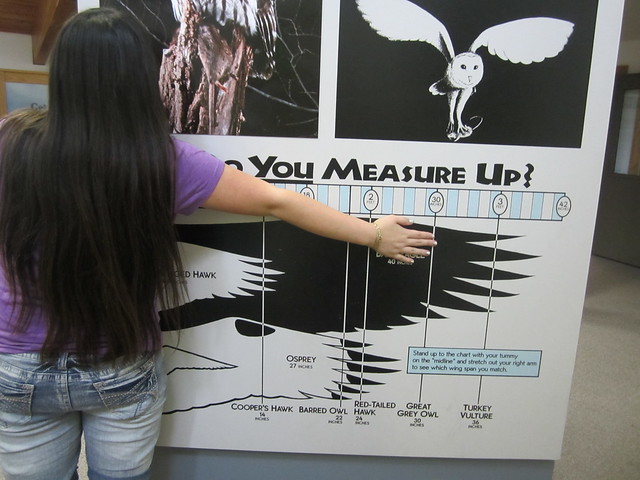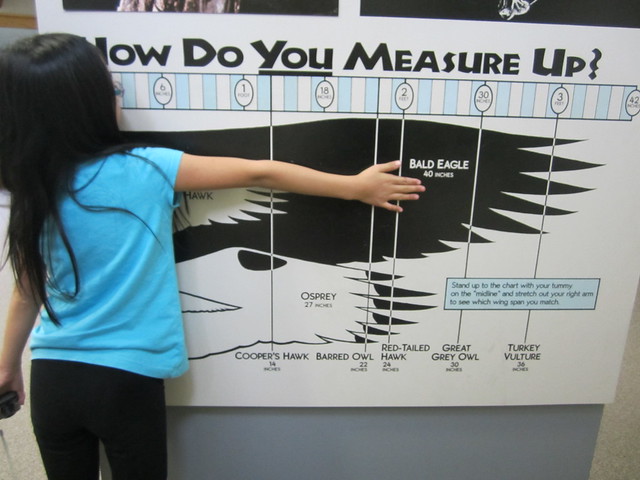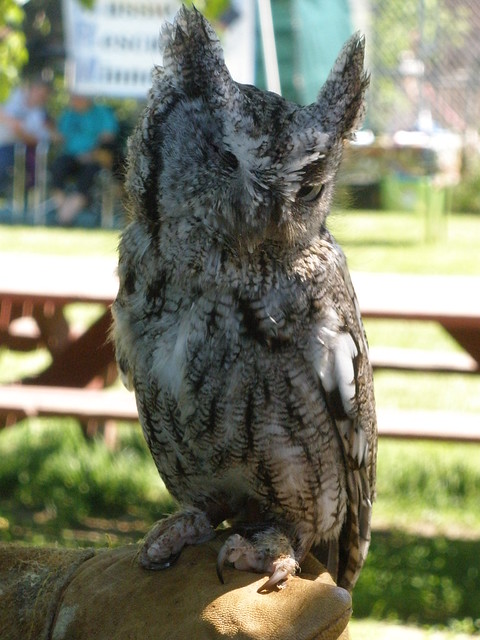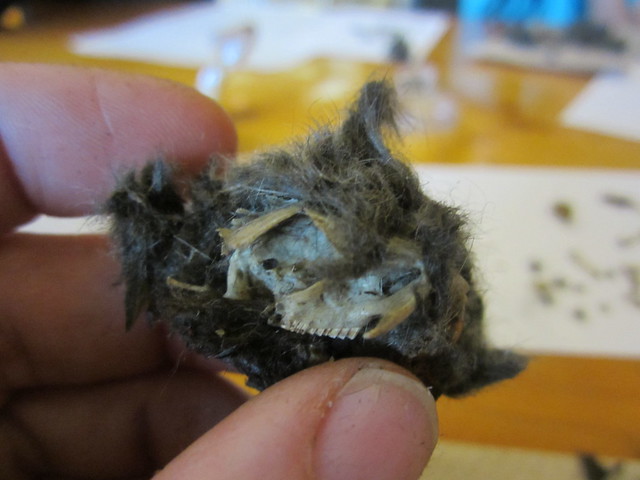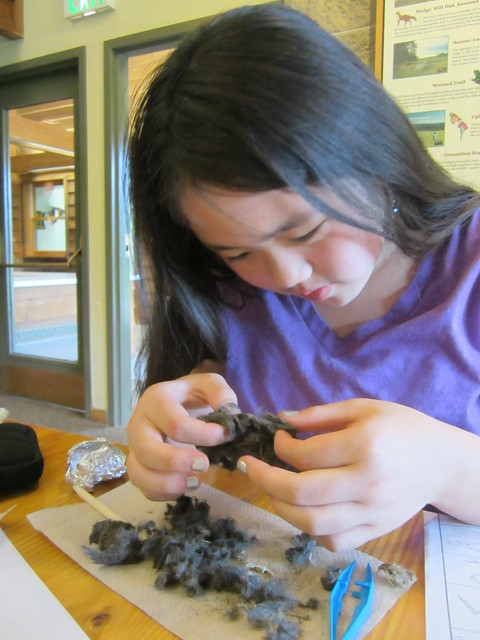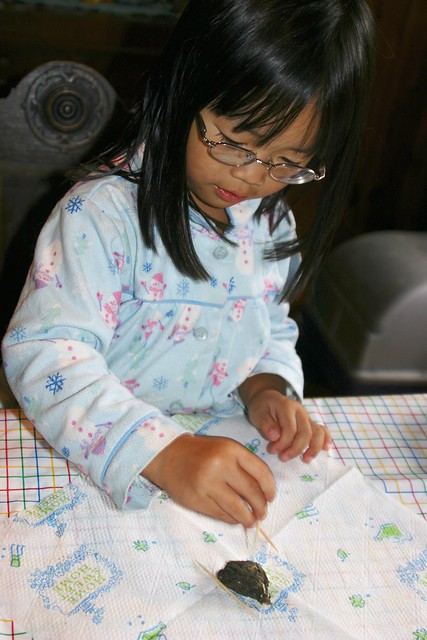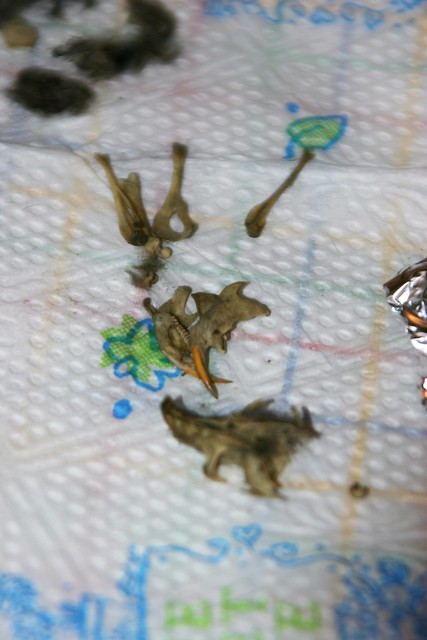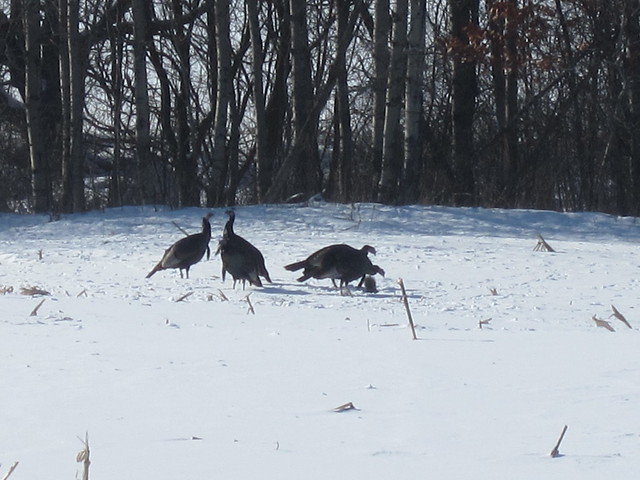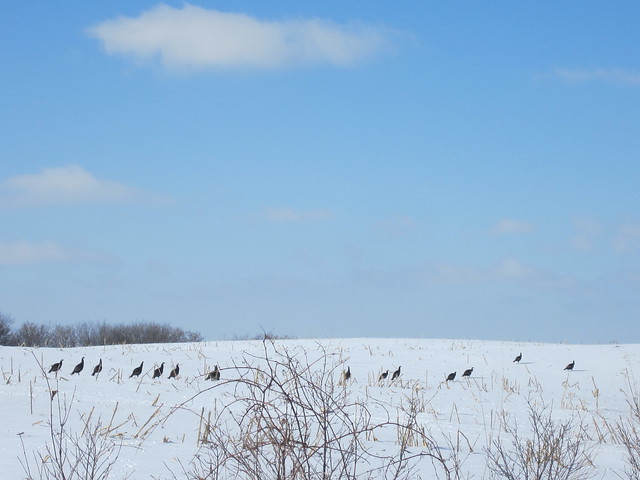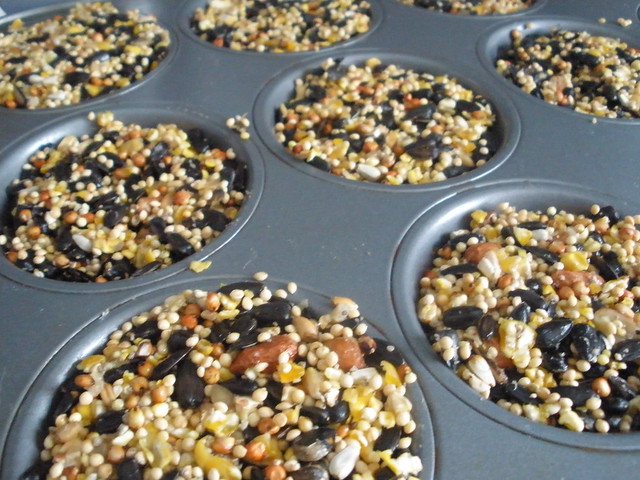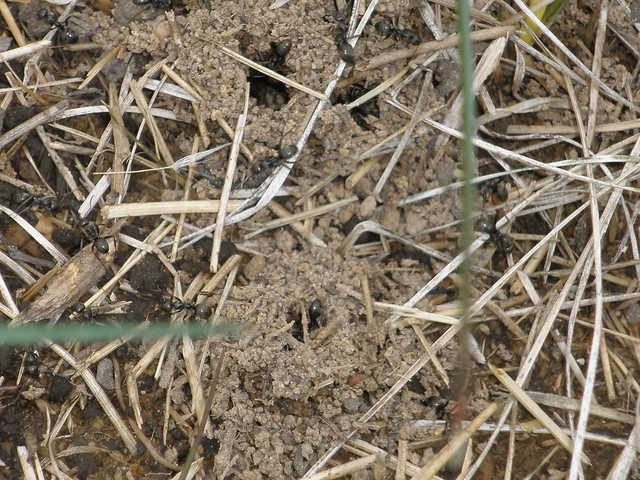The first artist that we focused on for the 2014-15 homeschool year was Fra Angelico (1395-1455) who was part of the Italian Renaissance period.
Fra Angelico (christened Guido di Pietro) quietly painted for the glory of God. Guido was born in Italy in about 1387. As a youth, he worked on illuminated manuscripts (a vividly-colored text that was hand-painted and lettered).
At the age of 20 years old, he dedicated his life to Christ by entering the Dominican Convent of Fiesole; and become a Dominican monk. It was there that he received the name Fra Angelico which means "the angelic one."
While he was a monk, he painted the walls within convents, monasteries, and churches. When the Dominicans moved to a new building in Florence, Fra Angelico was asked to paint murals to decorate the walls.
One of the things that is to be noted, according to Barry Stebbing in an article he wrote for
Homeschooling Today, is "...there is no expression or emotion on [people's] faces. This was the traditional way of painting during earlier centuries in Christian art. This style had b een handed down from one generation to another from as early as the beginning of the Byzantine period (A.D. 313 to A.D. 1453), and Fra Angelico remained true to its simplicity and spiritual purpose."
Stebbing continued, "Fra Angelico only painted when he was asked to do so by the church authorities. Before beginning, he prepared himself with fasting and prayer. It is said that he often wept whenever he painted the crucified Christ. Unlike many artists of his time who painted stories from Greek mythology, Fra Angelico only painted religious subject matter, focusing mainly on the deity of Jesus Christ."
When Fra Angelico died in 1455, he was called
beato - or blessed.
For the artist/picture study of Fra Angelico, Sophia and Olivia looked at six paintings by this artist for a period of time; and shared what they remembered about them when they no longer were looking at the paintings.
The Last Judgment
This painting (circa 1431) represents the Last Judgment, executed by Jesus. On the right side, are those condemned to Hell and on the left side it represents the saved ones and the saints. In the center, the opened tombs symbolize the resurrection of the dead.
Sophia Remembered:
=> The picture is split into three different aspects. The top part is the top half. In that part, the background is all white and it looks like it is in water.
=> In the center of that half of the picture there is a big, round oval-like area and the inside has lots of people surrounding it, and surrounding that there is an egg-shape center part which has Jesus sitting in the center almost looking like he's hovering.
=> Still in the white area there is a left and right wing with two rows on each side with people - like saints and kings and angels, and they have sort of a halo around them.
=> On the lower part of the inner egg-shaped part there are two angels that are leaning down holding trumpets.
=> Jesus has a sort of golden glow around him. You can't see his face that well, but he's not smiling or grimacing - he's sort of neutral.
=> On the bottom half, on the left-hand side there people who are dancing and wearing bright clothes. They look like they are praying to Jesus.
=> In the background you can see a bit of what might be a castle, but you can't see too much of it.
=> On the right hand side the people are cowering away from Jesus and have weapons - guns and knives - and are pointing it at the upper section. The area around them is brown, dead, and generally unappealing.
=> Behind them and to the right there are circles in the ground with people inside of them - sort of like tombs. There are also dead people on the ground. Generally everything is dark and gloomy on that side.
=> But on the other side, everything is green, flowers are blooming, and everything is bright and happy.
=> In the center, in between the left and right bottom part of the picture, leading up to the white section, is a white walkway and cut into the walkway are many square-shaped holes that run up and down the walkway.
=> At the very front of the picture on the walkway is a box that appears to be a coffin with its lid slightly cracked.
Olivia Remembered:
=> At the top there are these wings. On the two wings there are people on both sides, and in the center there is a person.
=> To the right of the picture, there looks like a battle going on.
=> To the left, there are happy people who are dancing. They look like they are celebrating something.
=> The main colors of the picture are red, blue, and white.
=> To the left, there looks like there is a castle.
=> To the far right, there looks like people who are dead.
=> In the middle of the picture, there is a stone walkway and on it is a box that is open.
=> There are lots of people in the picture.
=> The mood is both happy and sad.
*~*~*~*~*~*~*~*~*~*
Transfiguration of Christ, 1437-1446 Museo di San Marco, Florence
Sophia Remembered:
=> The picture is shaped like an egg with a flat side (the flat side is the bottom).
=> There is an outcropping of rocks and they're white and jagged.
=> The background is all golden and warm and glowy.
=> On the rock is an egg-shaped glow that is taller than a man. In front of that is a man wearing a white robe with arms out-stretched. He has a beard and shoulder-length hair that is a tannish-brown color.
=> There are seven people below him on the rock. Three of the six men are in front of Jesus, and are cowering down on the ground away from his bright light.
=> Then there are two other men with beards and they are back to the side of the picture. You can only see their heads so they look like headless things floating besides Jesus.
=> Between the men who are cowering and the men who are body-less, there are two more people. On the right there is a man and he appears to be a Friar because the top of his head is bald, but he has a ring of hair around his head. He has his hands clasped in prayer.
=> On the other side of the picture is a woman with a shawl over her head and she's looking at Jesus Christ solemnly.
=> Jesus is looking down on the men who are cowering with a look like he's giving them a test - like, can you withstand my brightness or glory?
=> The colors that she used in the picture are sort of pastel and around Jesus' head there is a halo except there is a red streak going up and to the sides.
Olivia Remembered:
=> There are people in it: Jesus and Mary (I think). One is a saint, I think. I don't know the other people.
=> Jesus is standing on a big, flat, grayish-yellowish-whiteish rock.
=> There is a big sun - but it looks like a big yellowish-whiteish egg.
=> The colors in the picture: brown, dark brown that looks like red, brown, white, gray, yellow, gold, and dark gold.
=> Two people are kneeling on the ground and wearing the brownish-reddish robes.
=> The people have these weird gold thingies on their head. Not halos. People don't wear them these days.
=> The background is a yellowish-goldish color with a gray trim around it.
=> Jesus is wearing a white robe and has a brown beard and hair. He has long hair - a little past his shoulders, but not much.
*~*~*~*~*~*~*~*~*~*
The Madonna with Saints, 1438-1443 San Marco Museum, Florence
Sophia Remembered:
=> The backgorund of the picture is a sky which appears to be dark blue. Below the dark blue sky is what appears to be a setting sun because it's a pale pink. But you can't see the sun because there are evergreens in front of where the sun.
=> On either side of the picture, there appears to be drapes that protrude a little bit into the picture.
=> Attached to the drapes are two garlands of what looks like apples that are strung up behind the throne.
=> A little bit in front of and on the ground is a platform that has a chair built into it...a throne, really.
=> You have to step down from the throne to get to the platform; and if you step down one more step there's a picture that's leaning against the top step. In the picture, Jesus is hanging from the cross with two people on either side.
=> On the left hand side of the throne, there are people who are more brightly dressed. On the right hand side, they aren't dressed as brightly. They appear to be priests and holy men.
=> At the moment, there are two people in front of the throne. One man has what appears to be cloth in front of his hands like a gift. The other man has his back to us, but he is appearing to be holding a cap in his hands as he faces the throne. Those two are the most brightly-dressed people.
=> Sitting on the throne is a woman and a baby. The woman who appears to be Mary is holding who appears to be baby Jesus.
=> The colors in the picture are subdued. They still are bright, but not as bright in real life.
=> No one is really smiling in this picture. They seem to be paying homage to the Lord's son because they have gifts in their hands.
Olivia Remembered:
=> In the picture there is a big group people wearing robes
=> In the background there is a bunch of pine trees and the setting sun in the night sky
=> There is a wall in front of the pine trees that looks very nicely done with black decorations and black stones.
=> On the stone wall, there are two torches that are spitting out fire.
=> There's a big chair wall thing that is hollow on the inside - it's a stone chair.
=> There are two people sitting on the chair - a mother and a baby. The baby does not have any clothes on. The mother has a red dress on with a blue cape or cloak.
=> The ground appears to be covered in a carpet or rug with scenes on it - like pictures.
=> On the right side there are a bunch of people with brightly-colored outfits, like red and blue. On the other side, there are two people wearing brightly-colored clothes and the other half are wearing black robes with white.
=> There are two people who are kind of in front of the throne. One of them is facing the front of the picture and is holding a silk piece of cloth and the other person is facing it (so you can see the person's back) and appears to be holding a box.
=> The people are the halo things. One of the people in the picture that is looking sideways is wearing black and what appears to be a bubble on his head.
=> In front of it, there is a picture on the ground with Jesus on the cross.
*~*~*~*~*~*~*~*~*~*
The Deposition from the Cross, 1443
This painting portrays Christ supported by several people, with Mary Magdalene keeping his feet, as a symbol of human repention. (Repention is to change mind or attitude against God.) A figure on the right, with a red hat, is showing the cross' nails and the horns crown, symbols of passion and sacrifice. Mary, wearing a dark dress, is showed in the traditional gesture of keeping hands joined.
Sophia Remembered:
=> In the picture, it looks almost like you could close it in on itself and wear it - like a locket.
=> There are bunch of people and they are drawn around a man who is being taken down from a cross, and some of the people are praying and some of them have halos around their heads.
=> There is a priest whose is kind of standing over Jesus. He has a black hat.
=> In the background there are trees of a dull olive green color.
=> At the front of the picture on the side where you would close the locket there are two golden pillars.
=> The background has the countryside and at the top it has been cut out to look like the three tines of a crown.
=> All of the picture has a little bit of gold in it. The back part, the columns, the edges.
=> The picture doesn't have a lot of very bright colors, but there is some red.
=> The picture has sort of a matte finish...it's not glossy or shiny. However, the gold in the picture does have some gloss.
=> The women are wearing dresses with head coverings and are a variety of colors.
Olivia Remembered:
=> The picture sort of resembles the death of Jesus and the rebirth of him.
=> At the bottom or the main section of the picture, you can see a bunch of people. Four of them are putting Jesus on the cross.
=> The three triangles at the top of the picture kind of reminds me of top of a throne.
=> The colors in the picture are red, blue, brown, gold, black, and a darkish-brownish-greenish color for the trees.
=> In the sky there are six angels. They seem to be talking with the angel in the middle of them.
=> The ground appears to made from black stones or flowers or coals. I'm thinking it's coals, though.
=> To the left, there is a city or town.
=> To the right, there is a big mountain or hill.
=> The people were wearing robes which were blue and red and maybe white and black.
=> Jesus was wearing a white thing around his waist - whatever that is - and that is about it. His hair is brown and you can't really see his face because he's dead.
=> To the right there were white clouds and to the left towards the city there were gray clouds - like smoke.
*~*~*~*~*~*~*~*~*~*
I found Fra Angelico's
The Annunciation and Life of the Virgin. It was painted in 1426 and is tempera on wood. It is at the Museo del Prado, Madrid. The three figures to the left of the painting represent Adam and Eve being escorted out of the Garden of Eden by an angel.
As Sophia began describing the picture to me, I realized she was looking at a different picture. She showed it to me, and sure enough...the painting
was a different one. The one that Sophia and Olivia was looking at was Fra Angelico's
The Annunciation that was done between 1438-47 as a fresco at the Convent of San Marco in Florence.
So, we stuck with the fresco that the girls had been looking at, and they shared what they remembered about it.
Sophia Remembered:
=> In the picture there are two females. One of them is sitting on a brown stool and she is bent slightly forward. She has a delicate face with a slight tinge of pink to her cheeks. The lady has blondish-orangeish hair with a red band around the top of her head. Her hair is short and doesn't fall past her shoulders. She has a golden halo around her head and is wearing a white dress with a red neckline, and blue shawl/blanket around her shoulders and on part of her lap. The blanket is a dark blue and the underside is golden. Her arms are crossed in front of her - almost like she's holding a baby, but she's not.
=> She's facing another lady who has blonde hair with a bit of gold in it and a halo. Her hair is slightly more curly around the edges, and she's wearing a pink dress with sleeves almost down to her wrist and gold embroidery at the neck of her dress and across the chest. The dress is about the shade of a pink rose, and the waist is like a Greek tunic style. The dress falls all the way to the floor. There's also gold embroidery at the floor - a few inches above the hem.
=> She also has a pair of wings...not angel wings... more like falcon/fast-flying wings. The wings are thin but sharp looking.
=> There are lots of different colors and patterns on her wings. There is red, gold, dark blue, blue...a wide variety.
=> The colors go from red and gold and yellow to darker colors at the end.
=> She has one foot forward and is slightly leaning on it, almost in a bow.
=> They are in a room that opens out onto a lawn and the entire room has archways that lead out. So, it is almost like being in a courtyard, but with a roof.
=> At the far end of the room, there is a door cut into the stone. Through the door you can see a a really tiny square window.
=> The outer walls are white but with a distinctive pinkish hue. The inside and part of the roof are more of a golden hue.
=> The walls, roofs, and column seem to be made out of something made from marble or granite. It's not new because there are cracks in it.
=> You can only see a little bit outside, but the part you can see there's a green lawn, a tall wooden fence, and beyond the fence are lots of tall, green trees.
=> There is plenty of light in the picture. It's not dull and dreary.
=> The pillars aren't very tall...probably a person's height and then it goes into the door.
=> At the top of the columns where they connect with the arch, there's a black line running around the inside of the columns. It's low enough that if one of the ladies stood up, they could touch it with the top of their heads. It's very weird.
=> The grass is a dark green. But it doesn't look like grass. It looks like carpet, partially because it looks like it is flat and has a pattern in it.
Olivia Remembered:
=> In the picture, there is a building with lots of arches and columns. It kind of looks like the Coliseum.
=> There are two people in the building. One of them is sitting on a stool and her arms are kind of folded.
=> She is wearing a white dress with a dark navy blue cloak.
=> She has a halo, so she is probably an angel, but she doesn't have wings.
=> The other woman has a pinkish-reddish dress with gold designs on it. She has a pair of wings that look like the wings of a falcon. They are pointy at the end and are sharp looking at the top.
=> The colors in the wings are a very dark blue, with a sky blue (maybe slightly darker). There is kind of an orange and yellow in the picture.
=> Outside of the building there is a fence.
=> The ground looks like it is made out of flowers.
=> The building looks like it is made out of marble with cracks in it.
=> The picture was set during nighttime so there is a candle on the ground by the door.
=> Through the door you can see a little square window.
=> There are lots of shadows - especially around the ceiling.
=> The columns are fancy at the top (not like the Greek columns that you see in temples - like the Temple of Athena...the Parthenon).
=> Behind the fence you can see trees that don't look like trees and big, tall shrubs.
*~*~*~*~*~*~*~*~*~*
Adoration of the Magi, 1445
Sophia Remembered:
=> In the round picture, there is a bunch of people who are coming from both sides of the picture. They are all coming down to see one person.
=> The person that they are coming to see is a naked baby who has blonde hair and is sitting in Mary's lap.
=> Mary has strawberry-blonde hair, but it looks like she has a boy-cut, and she has a halo around her head.
=> Mary is wearing a pink dress with a little bit of white around the collar.
=> She has purplish-blue robe over her dress with gold at the edge.
=> Next to her is Joseph. He has a brownish beard and a blue cloth over his head. It is covering his hair.
=> He has a shirt that is the same color as his head piece, and orange fabric around his shoulders and waist.
=> He has his left hand holding onto his orange wrap and his right hand up in a stop sign, but his fingers are curved in a bit.
=> His head is slightly turned down and he appears to be looking at the ground.
=> Behind him is a long line of people who are coming down from higher ground to see his son.
=> In front of Jesus there are people who are kneeling who are looking at him with awe and adoration.
=> There are many types of people who are coming to see him. Some have fancy dresses and jewelry. Others have merchants clothes, and others have clothes that have holes and patches in them.
=> There was a lot of orange and red in this picture. It's very distracting to the eyes.
=> Behind Mary and Jesus there is a barn. Because the barn is set on part of a hill, it is higher than where Mary and Jesus are sitting.
=> The barn has crumbling stone walls and a thatched roof. Because it is three-sided, it doesn't look very warm.
=> The front of the barn is slightly slanted because it is set on the hill.
=> Inside the barn there is a donkey that is eating out of a trough. Next to the donkey is a brownish-reddish cow that is laying down.
=> Further inside the barn are horses that appear to be being saddled by their riders.
=> To the right of the barn are the ruins of a big white structure. On the ruins are people who are wearing nothing but white cloths that are looking down upon the people who are coming to see Jesus.
=> Connected to the ruins of the white house is an archway that is above some of the people traveling to see Jesus.
=> On the side of the roof of the barn there is a peacock. It seems large next to the barn, but it is very pretty.
=> There is another bird that is flying down, but it is not a peacock. I think it is a pheasant or a quail.
=> On the left hand side of the picture, there appears to be a little patch of dark trees and shrubs. It seems dark and ominous compared to the rest of the picture.
=> Behind the white structure and barn, there is a couple of big rocks that are laying on the hill.
=> The atmosphere of the photo is cheerful and bright. But at the same time, not a lot of people are smiling.
=> Some of the people who are coming to see Jesus are riding horses.
Olivia Remembered:
=> There is a big giant mountain-like hill. Below it there is a barn, and behind the barn are buildings.
=> There are thousands of people in the picture coming from the top of the hill and beside it.
=> In the barn there is a donkey that is eating from a manger. Beside the manger, there is a cow that looks like a flaming cow because it is a reddish orange color.
=> Behind the donkey there are horses which have or are getting their saddles on; and there are horseshoes.
=> The colors in the picture are green, blue, red, brown, white, and a light tan - like the color of a person's skin.
=> Mary is holding a baby which is naked.
=> Besides Mary is Joseph who has a halo around his head. His is gold. Mary and Jesus have halos too. Jesus' halo is gold and red...it's not like a normal halo which is gold.
=> There are people surrounding Mary, Joseph, and Mary. They have very nice clothes and are giving gifts.
=> On the side of the people who are giving gifts is a dog. The dog is a dark brown and is staring at nothing.
=> On top of the barn there is a peacock. It doesn't look like a peacock, though, because it isn't a bright blue.
=> Also, there is another bird that I'm 100 percent sure is a pheasant.
=> To the left of the barn there are the ruins of a big, white building.
=> On these two big stone marble blocks there are five people who don't have normal clothes. They just have white cloths around their waists.
=> The ground appears to be black stones with little stones too.
=> There are a couple of trees in the picture, but not many.



